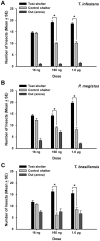A multi-species bait for Chagas disease vectors
- PMID: 24587457
- PMCID: PMC3937276
- DOI: 10.1371/journal.pntd.0002677
A multi-species bait for Chagas disease vectors
Abstract
Background: Triatomine bugs are the insect vectors of Trypanosoma cruzi, the etiological agent of Chagas disease. These insects are known to aggregate inside shelters during daylight hours and it has been demonstrated that within shelters, the aggregation is induced by volatiles emitted from bug feces. These signals promote inter-species aggregation among most species studied, but the chemical composition is unknown.
Methodology/principal findings: In the present work, feces from larvae of the three species were obtained and volatile compounds were identified by solid phase microextraction-gas chromatography-mass spectrometry (SPME-GC-MS). We identified five compounds, all present in feces of all of the three species: Triatoma infestans, Panstrongylus megistus and Triatoma brasiliensis. These substances were tested for attractivity and ability to recruit insects into shelters. Behaviorally active doses of the five substances were obtained for all three triatomine species. The bugs were significantly attracted to shelters baited with blends of 160 ng or 1.6 µg of each substance.
Conclusions/significance: Common compounds were found in the feces of vectors of Chagas disease that actively recruited insects into shelters, which suggests that this blend of compounds could be used for the development of baits for early detection of reinfestation with triatomine bugs.
Conflict of interest statement
The authors have declared that no competing interests exist.
Figures



References
-
- Coura JR, Dias JCP (2009) Epidemiology, control and surveillance of Chagas disease: 100 years after its discovery. Mem I Oswaldo Cruz 104: 31–40. - PubMed
-
- Zeledón R, Rabinovich JE (1981) Chagas disease: An ecological appraisal with special emphasis on its insect vectors. Annu Rev Entomol 26: 101–133. - PubMed
-
- Cortez MR, Monteiro FA, Noireau F (2010) New insights on the spread of Triatoma infestans from Bolivia—Implications for Chagas disease emergence in the Southern Cone. Infect Genet Evol 10: 350–353. - PubMed
-
- Patterson JS, Barbosa SE, Feliciangeli MD (2009) On the genus Panstrongylus Berg 1879: Evolution, ecology and epidemiological significance. Acta Trop 110: 187–199. - PubMed
-
- Costa J, Almeida CE, Dotson EM, Lins A, Vinhaes M, et al. (2003) The epidemiologic importance of Triatoma brasiliensis as a Chagas disease vector in Brazil: a revision of domiciliary captures during 1993–1999. Mem I Oswaldo Cruz 98: 443–449. - PubMed
Publication types
MeSH terms
Substances
LinkOut - more resources
Full Text Sources
Other Literature Sources
Medical
Miscellaneous

